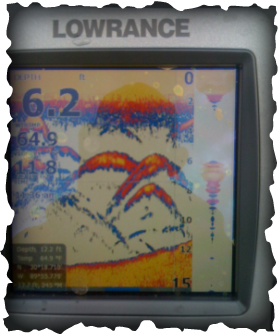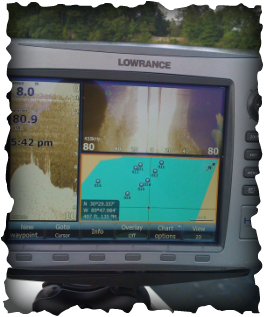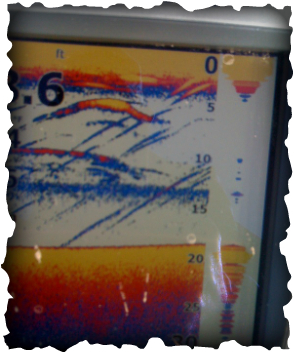
It was a hot summer day. I was putting through the massive no wake zone in Madisonville. While looking at the screen of my GPS /Sonar / Structure Scan unit I think about how I have not even begun to use this unit to it’s full potential. Seeing how I have spent a lot of money on it I think it’s about time to start making it work for me. Now before I get into finding bass off shore I need to cover a few basics of sonar, and Structure Scan. Both use sound to create a image of what is below the transducer. Sonar uses a clicking sound called a ping. It bounces off of objects at different rates to make a picture. Now these images can be puzzling, because sonar has high sensitivity. This can show you a small drop shot rig as it falls to the bottom, but you generally get a lot of clutter. This clutter tens to be greater around structure that comes off of the bottom. If you turn the sensitivity down you will miss smaller objects, and fish. Fish will appear as a arch. This is because the signal bounces off of the tale, over the back, back down to the head. That is where the arch comes from. If the fish is more side ways the arch will be tighter. Bait fish will generally look like a blob with fish swimming around them. The way that I look at it to help me understand is it’s like a radar image under water. If you see a boat on radar it looks like a blob. Same with bushes, or balls of bait fish. Structure Scan sends out a beam of sound that gives you a picture like image of the bottom. This picture is so clear the objects look just like what they are. If it’s a tire, you see a tire. It looks like you are shining a flash light out across the bottom. If there is a pylon sticking up out of the bottom, you can tell which way it is leaning by looking at the shadow. You can tell if fish are suspended by how far their shadow is behind them. This technology is well on its way to being the future of the underwater search for fish. I personally hope that sonar stays around though. While the Structure Scan is amazing, it works best at idle speed only. At fishing speed the images become to burry to make out. To clear them up you have to turn the scroll speed down so slow you will find yourself no longer looking at it. I also find it harder to see fish on the down scan as well. They just blend in to well. These are the reasons I still use sonar along with Structure Scan.

Now to find the bass it takes lots of time, and patience. You need to be constantly looking at your screen to find anything that could hold a fish. Always remember that food controls bass more than weather. They look for ambush points so that they do not have to work to hard for a meal. It could be a log, or a bunch of logs on the bottom. A thermocline. A channel drop. A small hump in the middle of no where. One thing I have learned is never underestimate anything. One time I found a little hump about half as big as my boat in 18 feet of water. The top of the hump came up to around 15 feet. To the side was a drop off into 23 feet. I saw two fish hiding on the down current side. I marked it then spun around. After setting up about 30 feet off of the mark I flung a deep diving crank bait out there. It took a few cast to find the right line. Then when I felt it finally drag the top of the hump I got a bite. I drug in a small bass, and let him go. I chunked the crank bait right back down the same line. Again. Drag the hump. Then WHAM! Another fish. If you get on the right spot, and keep your bait in the right area you could catch your limit quick. Where to look can be a donating task as well. To find channel drops look at where water flows most of the time. If your in a dead end bay the bottom will be flat. If there is a bayou flowing out of the back of that bay you will find a channel. This is where satellite maps come in handy. Look for a junction of two bayous. Also look in the outside bends of a main bayou, or river. Those banks have steeper drops, and may have trees stuck into the bottom under the water. These trees flow down the river, and get lodged into the bottom along the outside of the bend. Also in the middle of the bayou in a bend. There you will find the other drop off witch is basically a underwater point. To the left is a picture of a under water point that I was marking. You can see all the way points in a line. Those are on the top of the point. On the left is a image of the bottom bellow the boat. You can see grass coming up from the bottom as the point starts to drop off into deeper water.

Channels can be hard to fish. Try not to think of it as your away from the bank. Think of the channel drop as the bank. It’s just under water. I mentioned Thermocline while talking about what to look for. I feel this needed to be explained more. A Thermocline is the depth where there is the biggest temperature change. This happens in the warmer months. The hot water at the surface has very little oxygen. At the Thermocline the bass find a temperature they are comfortable with, and the oxygen they need. These fish will be more active then the shallow fish. It will appear as a fuzzy line on the screen above the bottom. It will be a straight line that does not follow the bottom. The depth of it will vary. The easiest fish to catch will be the ones holding on structure that come up into the Thermocline. To stay on the fish after you find them is easy around here. Have your spot marked on your GPS. Zoom all the way in so you can see how far away you are. Creep up on the spot from the down current/wind side. Start throwing till you hit the cover. Once you find it you should look for three landmarks in a triangle. One in front to cast to, and one on each side to keep your boat in position. If you keep those three marks lined up you should be able to repeatedly hit your structure. You could also use a marker buoy dropped off of your bow. If you have a color screen unit you will find objects that are by the edge of your sonar cone will be a darker blue. As the get closer to the center of the cone they turn a more red, and yellow mix. So if your watching your drop shot bounce on your screen, and you keep seeing dark fish arches swim by you might need to move over a little. There is a wide range of lures that will work off of the bank. You can bash a big crank bait through it. You could swim a swim bait. Drag a spinner bait……… The list goes on, and on. I have caught fish on big crank baits one day, then watched a fish take my drop shot on my screen the next. It all boils down to what your comfortable with in the current conditions. Anything you use on the bank will work, at times, off of the bank. You just need to remember that the water will be a different color down there, so pick your colors wisely. Finding, and catching bass with your sonar can be very difficult at times. It can also be very rewarding. Now there are times where fish on the banks are all you can catch, and vice-verse. If you're like me though, you don’t like to fish behind someone. When you see a nice spot on the bank, everyone has seen it and probably fished it already as well. If you take the time to find you some underwater “ Honey Holes” you won‘t have to fish something that has been pounded on. Now that its getting hot outside the water temps are on the rise. More, and more fish are moving out waiting to be caught. I hope this has helped you in your search for bass. Below are some photos that I thought were interesting. Good luck to all!
S









